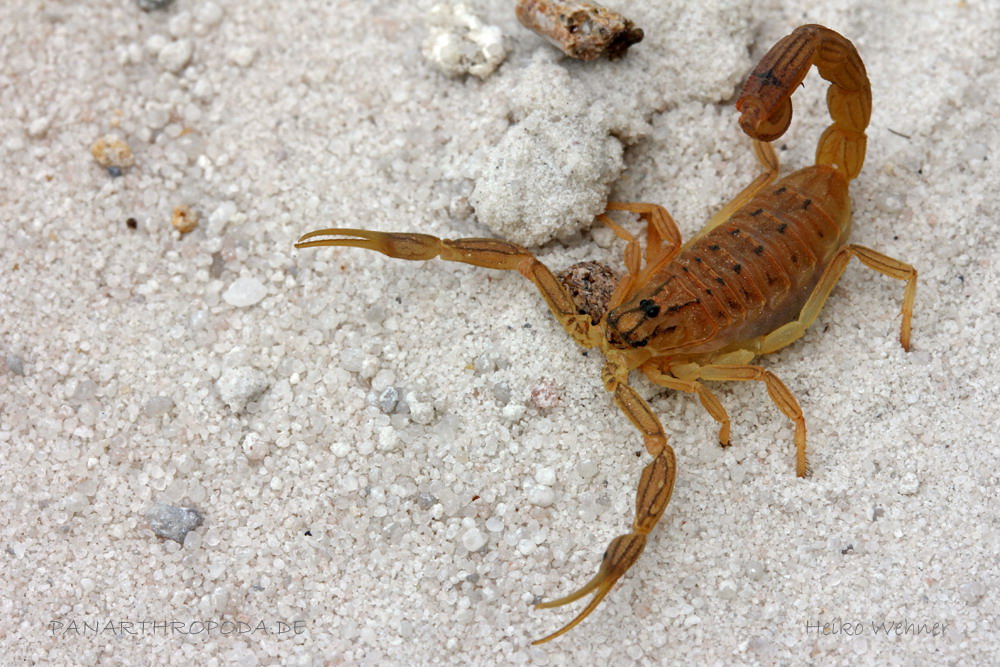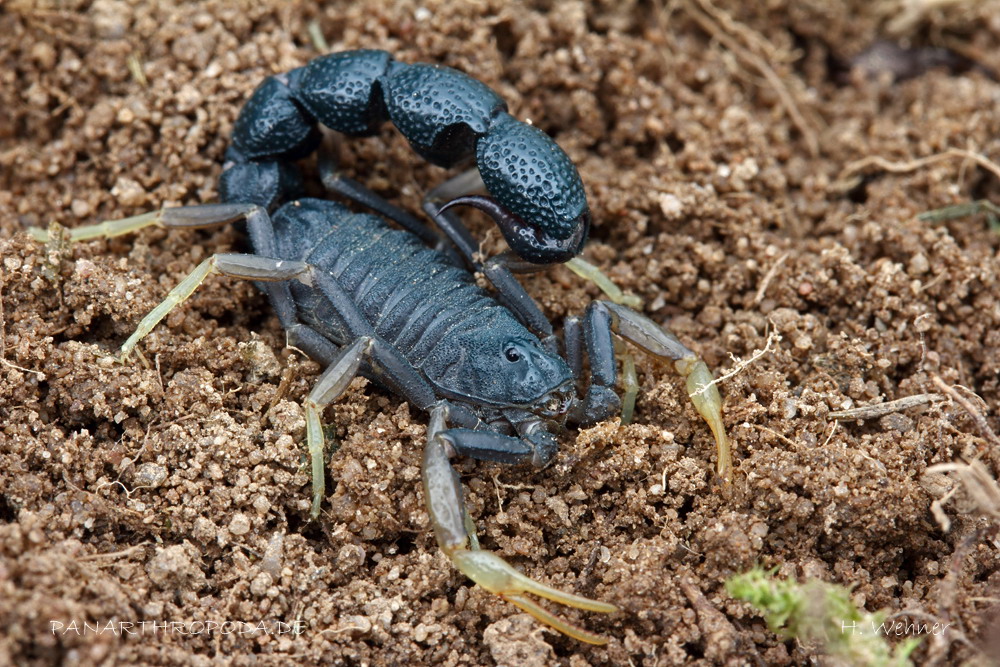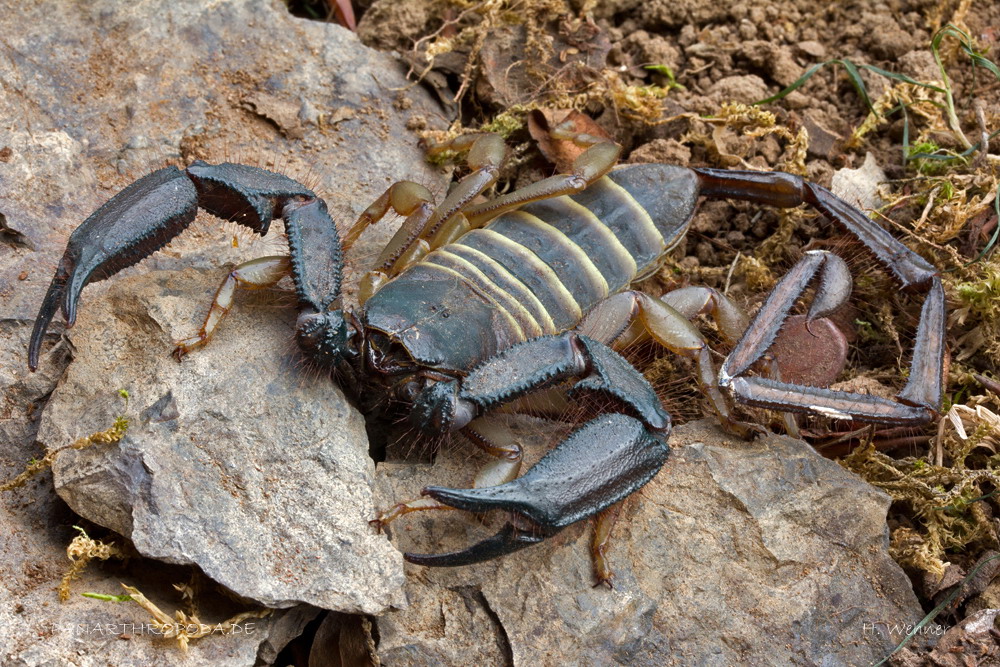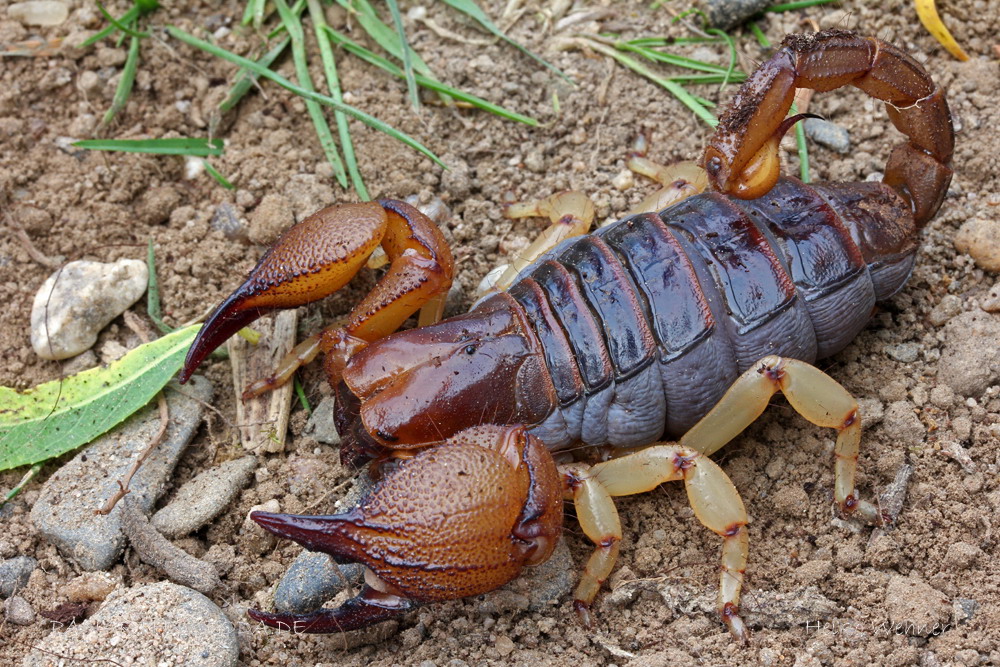- Arthropoda (Arthropods)
- Mantodea (Mantids)
-
Insecta

The order of the scorpions (Scorpiones)

Hottentotta arenaceus belonging to the family Buthidae
The group consisting of the recent scorpions comprises approximately 1500 living species (Prendini & Wheeler, 2005) and together with extinct species forms a phylogenetic entity within the infraorder Orthosterni of the suborder Neoscorpionina (Polis, 1990, p144). The basic appearance of palaeozoic scorpions, which occurred 450-425 mio. years before present in the Silur, resembles that of recent scorpions regarding most characteristics (Polis, 1990, p1, p137).
Scorpions are viviparous which in arachnids is solely also known in some mites (Acari) (Polis, 1990, p158). The mating follows a highly ritualized behaviour, which is also known as the promenade à deux (Maccary, 1810), at which the male deposits a spermatophore at the end from which the female takes up the sperm package (Alexander 1956; Alexander, 1957; Alexander, 1959; Angermann; 1955; Bücherl 1955/56; Zolessi 1956).
After birth the young climb up to the dorsal surface of the mother and stay there until they molt (Polis, 1990, p190).
Most scorpions are generalist predators (Polis, 1990, p294). All scorpions are venomous and the venom is produced in paired venom glands, which are located in a stinger that is used for the injection (Polis, 1990, p54). The scorpion venom consists of a complex mixture of peptides with diverse physiological and pharmacological effects. The venom also contains enzymes, nucleotides, lipids and biogenic amins (Chippaux & Goyffon, 2008). Only about 40 species, of which most are part of the family Buthidae, can be considered as generally dangerous for humans (Chippaux & Goyffon, 2008).
Apart from Antarctica scorpions occur in all bigger landmasses (Polis, 1990, p249). The geographical distribution of scorpions ranges from up to 51° latitude in north and to the most southern parts of South Africa and South America. Hence the distribution of scorpions is mainly restricted to the tropics, subtropics and warm temperate zones (Stockmann & Ythier, 2010).
The habitats exhibiting the highest diversity of scorpion species are deserts (Gertsch & Allred, 1965; Hibner, 1971) which is in contrast to the situation found in most animal groups, where the tropics are the habitats of highest diversity (MacArthur, 1972). However scorpions occur in virtually all terrestrial habitats except the Tundra, Taiga (high-latitude Taiga) and very high mountain regions (Polis, 1990, p251).

Orthochirus afghanus belonging to the family Buthidae
The scorpion's body is divided into a pro- and opisthosoma and the junction between this two tagmata is not constricted. The opisthosoma is divided in the mesosoma, which consists of 7 segments, and a narrowed metasoma consisting of 5 segments.
The pedipalps of scorpions are modified to pincer bearing arms. The pincers are formed by the tibia and tarsus which collectively are termed chelae. The pedipalps are used for prey-immobilisation, defense, sensoric matters and for grasping the pedipalps of the partner while mating. The four furthermore appendages of the prosoma consist of the walking legs, which are mainly ambulatory appendages.
The second mesosomal segment bears a pair of comb-like appendages (Pectines) which represent unique sensoric structures which solely occur in scorpions and mainly function in mechanoreception and contact-chemoreception (Foelix & Müller-Vorholt, 1983; Ivanov & Balashov, 1979; Polis, 1990, p20).
Subsequent to the last metasomal segment resides the telson, that evolved into a stinger. The telson is subdivided into a vesicle, in which lay the paired venom glands, and the aculeus that forms the structure for the injection of venom into the prey or an enemy. The ducts of the venom glands lead to the surface just prior to the tip of the aculeus (Polis, 1990, p10-15).
A basic body plan, that consists of a subdivision of the opisthosoma, the presence of chelate pedipalps, a stinger that is derived from the teslon and the possession of pectines, is common for all scorpions (aquatic and terrestrial palaeozoic as well as recent scorpions) (Polis, 1990, p154).
Recent scorpions are in close phylogenetic relationship and in comparison with very diverse groups like spiders or harvestmen show only few morphological differences, in which of course ecomorphological differences occur (Polis, 1990, p145).
Fossil records of palaeozoic scorpions show a greater diversity in the past, in which especially the position of the coxae of the walking legs in relation to the sternum were more variable. This stays in contrast to the situation in recent forms where these are much more consistent (Polis, 1990, p137).

Hadogenes paucidens male belonging to the family Hemiscorpiidae
Early scorpions were marine or amphibious and can be distinguished from terrestrial scorpions by different characteristics (Kjellesvig-Waering, 1986).
The extinct suborders of the Brachioscorpionina comprise all scorpions that possessed ventral mesosomal abdominal plates (which occurred instead or additionally to sternites) which covered gills. The morphology of the abdominal plates could vary (Kjellesvig-Waering, 1986).
Many Brachioscorpionina possessed lateral compound eyes (Kjellesvig-Waering, 1966; Kjellesvig-Waering 1986; Paulus, 1979; Wills, 1947) which are reduced to a few single lateral eyes in recent forms (Polis, 1990, p149).
Marine and amphibious scorpions are known up to the Carbon (300-250 mio. years before present). The first terrestrial scorpions presumably arose in the late Devon respectively the early Carbon (350-325 mio. years before present) (Polis, 1990, p2).
The conversion to a terrestrial life led to an adaption of the body appendages, to the loss of the abdominal plates and the associated gills and by an evolutionary replacement by booklungs which are in contact to the exterior by openings in the sternites (spiracles) (Polis, 1990, p147-149). Furthermore the coxae of the pedipalp and the first and often also the second segment extended by building apophyses that take part in forming an preoral chamber (Polis; 1990, p149; Shultz, 2007).
Early scorpions possessed a mesosoma that consisted of 8 segments, which is in contrast to the 7 segmented mesosoma of recent forms (Polis, 1990, p147-149).
Completely terrestrial scorpions are classified in the infraorder Orthosterni which is the sole infraorder of the suborder Neoscorpionina (Polis, 1990, p144). After this point of view the suborder Brachioscorpionina could be considered as being paraphyletic, because Kjellesvig-Waering (1986) assumes that the infraorder of the aquatic/amphibious lobostern scorpions (which classically are considered as being part of the Branchioscpioninae) has a common ancestor with the terrestrial orthostern scorpions. The division of the order Scorpiones in the suborders Branchiscorpionina and Neoscorpionina therefore should rather be a morphological than an phylogeneticaly founded one.

Opistophthalmus glabrifrons belonging to the family Scorpionidae
The taxonomic position of the scorpions within the subphylum of the Chelicerata is substance for many discussions and many different opinions exist about their relationships to the other groups in this subphylum.
It is presumed that the lineage of the scorpions emerged from a group of eurypterids (sea scorpions, an extinct class within the Chelicerata (not to be confounded with marine scorpions of the order Scorpiones)) (Bergström, 1979; Boudreaux, 1979; Kjellesvig-Waering, 1986; Størmer, 1963; Weygoldt & Paulus, 1979a, b).
This assumption is founded on the occurrence of a set of characteristic morphological traits, that the eurypterids and the scorpions have in common, but in which some are interpreted as being due to convergent evolution (Størmer, 1963; Weygoldt & Paulus 1979a). After some hypothesis the eurypterid group from which the scorpions emerged also gave rise to the remaining arachnids, that would result in the aquatic and terrestrial scorpions being the sister-taxon of the remaining arachnids (Lipoctena, pectines missing arachnids) (Weygoldt, 1998).
Though, it is also possible that the lineage of the pectines missing arachnids emerged from a lineage within the scorpions, which led to the evolution of terrestrial scorpions on the one hand and of the pectines missing arachnids on the other hand.
This would implicate that the order of the scorpions would become paraphyletic and that the palaeozoic scorpion-like chelicerates would have to be excluded of the order Scorpiones (Weygoldt, 1979b; Weygoldt, 1998).
An other hypothesis tends to a scenario, where the pectines missing arachnids arose from a lineage of the Merostomata (Merostomata is a term referring to an assumable non-phylogenetic grouping of the Xiphosurida and Eurypterida) (Polis, 1990, p155).
The characteristic traits that define the group Arachnida are mainly due to the transition from an aquatic to a terrestrial lifestyle, which though is only shared with the orthostern scorpions.
In the light of these findings it could be possible that only the orthostern scorpions share a common ancestor with the pectines missing arachnids what could probably mean that the pectines missing arachnids, as questioned before, could have emerged from a scorpion lineage which could be connected to a single transition from an aquatic to a terrestrial lifestyle (Weygoldt, 1998).
It could indeed also be possible that the terrestrialization occurred more than one time within the Chelicerata, once within the orthostern scorpions and a second time in the ancestor of the arachnids (scorpions excluded). Fossil records of pulmonate mites (Acari) and Trigonotarbida (extincted arachnid order) from the lower Devon could be seen as argument supporting this hypothesis (Polis, 1990, p155).
These hypothesis also supports the assumption that the arachnids might be an diphyletic or even polyphyletic assemblage (Bergström, 1980; Smith, 1990).
Van der Hammen (1977) assumes that an even higher number of independent terrestrialization events occured within the chelicerates, cotradicts the classical classification within the chelicerate goups, and proposes the establishment of more independent groups, where the scorpions build up an entire class.
Findings about the embryonal development of scorpions and of other arachnids contradict the hypothesis of a common ancestor of the scorpions and pectines missing arachnids (Anderson, 1973).
Shultz (1990) argues for the hypothesis of a convergent evolution regarding the adaption to a terrestrial lifestyle, though without assuming a polyphyletic origin of the arachnids (scorpions included). After his proposal of a phylogenetic classification the Scorpiones represent the sister-taxon of the group Haplocnemata, which comprises the Pseudoscorpiones and the Solifugae (camel spiders). The grouping of the Scorpiones and Haplocnemata here represents the sister-taxon of the Opiliones (harvestmen).
After Shultz (2007) the Scorpiones form the sister-taxon of the Opiliones and together are grouped in the Stomthecata. This grouping is based on the presence of a preoral chamber, which is formed by the contribution of coxapophysis of the pedipalps and the first and second pair of walking legs and additional similarities (Shultz, 2007).
Fossil scorpions do not exhibit such stomothecae (Kjellesvig-Waering, 1986) which for Weygoldt (1998) is a factor that does not permit to understand the stomothecae as a synapomorphy for this group, but rather as convergent evolution.
References
Alexander, A. J. (1956). Mating in scorpions. Nature, 178, 867-868.
Alexander, A. J. (1957). The courtship and mating of the scorpion, Opisthophtalmus latimanus. Proceedings of the Zoological Society, London, 128, 529-544.
Alexander, A. J. (1959). Courtship and mating in the buthis scorpions. Proceedings of the Zoological Society, London, 133, 145-169.
Anderson, D. T. (1973). Embryology and phylogeny in annelids and arthropods. International Series of Monographs in Pure and Applied Biology, Zoology Division, Pergamon, New York, 50.
Angermann, H. (1955). Indirekte Spermatophorenübertragung bei Euscorpius italicus Hbst. (Scorpiones, Chactidae). Naturwissenschaften, 42, 323.
Bergström, J. (1979). Morphology of fossil arthropods as a guide to phylogenetic realtionsships. Gupta ed., 3-56.
Bergström, J. (1980). Morphology and systematic of early arthropods. Abh. Naturwiss. Ver., Hamburg (NF), 23, 1-42.
Boudreaux, H. B. (1979). Arthropod phylogeny with special reference to insects. Wiley, New York.
Bücherl, W. (1955/56). Escorpiões e escorpionisme no Brasil. V. Observacões sobre o aparleho reproductor masculine e o acasalamento de Tityus trivittatus e Tityus bahiensis. Memorias do Instituto Butantan, Sao Paulo, 27, 121-155.
Chippaux, J.-P., Goyffon, M. (2008). Epidemiology of scorpionism: A global appraisal. Acta Tropica, 107, 71-79.
de Zolessi, L. D. (1956). Observaciones sobre el comportamiento sexual de Bothriurus bonariensis (Koch) (Scorpiones, Bothriuridae). Boletín de la Facultad de agronomía. Universidad de la República, Montevideo, 35, 1-10.
Foelix, R. F. & Müller-Vorholt, G. (1983). The fine structure of scorpion sensory organs. II. Pecten sensilla. Bulletin of the British Arachnology Society, 6, 68-74.
Gertsch, W. J. & Allred, D. M. (1965). Scorpions of the Nevada test site. Brigham Young University Science Bulletin, Biology Series, 6, 1-15.
Hibner, A. (1971). The scorpions of Joshua Tree National Monument. Master’s thesis, California State College, Long Beach.
Ivanov, V. P., & Balashov, Y. S. (1979). The structural and functional organization of the pectin in a scorpion Buthus eupeus Koch (Scorpiones, Buthidae) studied by electron microscopy. The fauna and ecology of Arachnids, Trudy Leningradskogo Obshchestva Estestvoispytatelei, Leningrad, 85, 73-87.
Kjellesvig-Waering, E. N. (1966). Silurian scorpions of New York. Journal of Paleontology, 40, 359-375.
Kjellesvig-Waering, E. N. (1986). A restudy of the fossil Scorpionida of the world. Paleontograpica Americana, Paleontological Research Institute, Ithaca, New York.
MacArthur, R. H. (1972). Geographical ecology, Haper and Row., New York.
Maccary, A. (1810). Memoire sur les scorpion qui se trouve sur la montagne de Cette. Paris: Gabon.
Paulus, H. F. (1979). Eye structure and the monophyly of the Arthropoda. Gupta ed., 299-383.
Polis, G. A. (1990). The Biology of Scorpions. Stanford University Press, Stanford, California.
Prendini, L. & Wheeler, W. C. (2005). Scorpion higher phylogeny and classification, taxonomic anarchy, and standards for peer review in online publishing. Cladistics, 21, 446-494.
Stockmann, R., & Ythier, E. (2010). Scorpions of the World. NAP Editions, Verrières-le-Buisson, France.
Shultz, J. W. (1990). Evolutionary morphology and phylogeny of Arachnida. Cladistics, 6, 1-38.
Shultz, J. W. (2007). A phylogenetic analysis of the arachnid orders based on morphological characters. Zoological Journal of the Linnean Society, 150, 221-265.
Smith, E. L. (1990). An arthropod morphologist looks at six hundred million years of chelicerate evolution. Newsletter of American Arachnology, 42, 3-5.
Størmer, L. (1963). Gigantoscorpio willsi, a new scorpion from the Lower Carboniferous of Scotland and its associated preying microorganisms. Skrifter av det Norske Videnskaps-Akademi, Oslo I, Matematisk-Naturvidenskaepling Klasse, 8.
Van der Hammen, L. (1977). A new classification of Chelicerata. Zoologische mededelingen, 51, 307-319.
Weygoldt, P. (1998). Evolution and systematic of the Chelicerata. Experimental & Applied Acarology, 22, 63-79.
Weygoldt, P. & Paulus, H. (1979a). Untersuchungen zur Morphologie, Taxonomie und Phylogeny der Chelicerata. I, Morphologische Untersuchungen. Zeitschrift für zoologische Systematik und Evolutionsforschung, 17, 85-116.
Weygoldt, P. & Paulus, H. (1979b). Untersuchungen zur Morphologie, Taxonomie und Phylogenie der Chelicerata. II. Cladogramme und die Entfaltung der Chelicerata. Zeitschrift für zoologische Systematik und Evolutionsforschung, 17, 177-200.
Wills, L. J. (1947). A monograph of British Triassic scorpions. Monographs of the Plaeontological Society, London.
F. Schramm, authored 2011